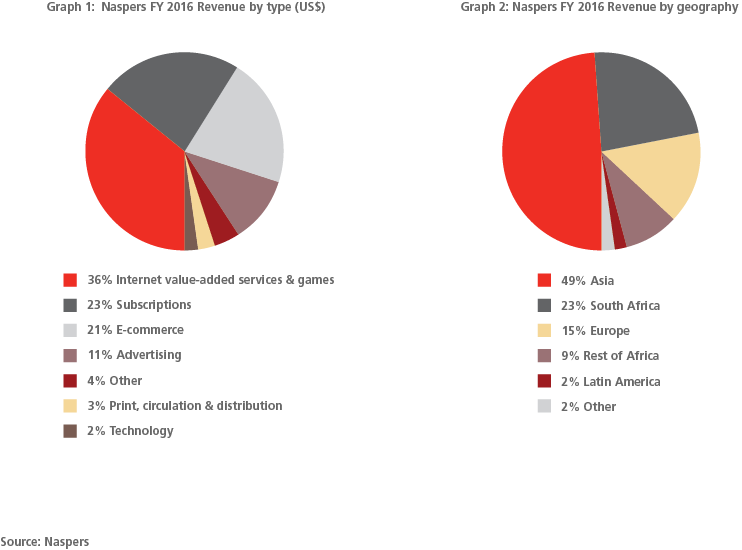Naspers: Making sense of the elephant in our equity market
Now that global internet giant Naspers’ weighting in South Africa’s equity market has risen to nearly 17% – far more than the next-largest companies MTN and Sasol at 4.2% each – it is likely to represent a large share of many local investment portfolios. It therefore makes sense for Prudential to help investors better understand the company in its current far-reaching form.
From Stellenbosch media company to global tech giant
Most investors would probably know that Naspers (originally De Nasionale Pers) started as a small South African media group in 1915, publishing and printing newspapers, books and magazines. As technology evolved in the 1980s and 1990s, it expanded into local pay TV services (Mnet, DStv), and internet services (Mweb, News24).
It was 2001 when then-CEO Koos Bekker embarked on an ambitious globalisation strategy: the company bought 46% of Chinese internet company Tencent, so beginning Naspers’ rapid transformation into an international internet and entertainment powerhouse as it capitalised on the exponential spread of digital services around the world, focused particularly on emerging markets. Over the last 15 years it has been successful in using the high levels of cash generated by its South African (and latterly African) businesses, which are largely subscription-based, to acquire stakes in internet companies it identifies as being capable of strong growth, with Tencent being its jewel in the crown to date.
Today, the company operates in 130 countries around the world and as an investment holding company it owns or has interest in some 44 well-known brands. Annual revenues stand at over US$12 billion, with only 4% of this total coming from its original print/media operations in South Africa. Approximately 24% is generated from its African (including South Africa) digital terrestrial TV and video entertainment businesses, and the lion’s share of revenue, some 72%, comes from its global internet operations.
Within Naspers’ global internet operations, profitability is improving: the group owns stakes in 23 separate ecommerce businesses that are profitable – up from 18 a year earlier – although some do remain loss-making. Tencent dominates the group’s revenue and profit growth despite its ownership stake having been diluted since 2001 to 34%: Tencent’s profits most recently grew by 43%, while Naspers’ overall internet business profits grew by 53%.

Tencent, a Chinese giant and still growing
Founded in 1998 and listed in Hong Kong in 2004, Tencent is one of the largest internet services companies in the world, offering media, entertainment, internet and mobile value-added services, gaming and online advertising. Its services include social networking, internet portals (QQ.com is one of China’s biggest), ecommerce, multi-player online games (QQ Games), online payments, and instant messaging (Tencent QQ, WeChat,). Its income is derived from online advertising, subscriptions and sales to premium users of its games, ecommerce sales (business-to-business, business-to-consumer and consumer-to-consumer), and licensing of games, among other sources. More recently it has expanded into the distribution of foreign music, sports and films in China, smart interactive TV services, cloud storage services and a tax-hailing business with autonomous driving aspirations. Finally, in March this year the group took another big step with the acquisition of a 5% stake in Tesla, the ground-breaking electric car manufacturer. Tencent now encompasses over 20 subsidiaries and several wholly owned enterprises.
For its financial year to the end of 2015, the group reported total annual revenue of $15.8 billion, a 30% increase over the previous year, while net profit was $4.5 billion, up 22%. Its operating margin was 39%. Most recently, for its third-quarter 2016 results it reported $1.5 billion in net profit, representing growth of 43% y/y. A large part of this growth stemmed from the rising popularity of WeChat and its mobile gaming apps. Launched only five years ago, WeChat now boasts some 846 million users, up 30% from a year earlier, and is rapidly expanding its online advertising revenues.
Building a Russian internet empire
Naspers also owns a large stake in Mail.ru, a London-listed internet group based in Russia that started out in 1998 as an email provider and is now a major online service provider and portal for the Russian-speaking segment of the internet. It has recently become Russia’s largest internet company, with its products reaching 94% of Russian internet users. It also controls the country’s three largest social networks (Vkontakte with 90 million monthly users, Odnoklassniki and Moi Mir) and two instant messaging networks (Mail.ru Agent and ICQ). It offers numerous online games, a search engine and is also a leading Russian ecommerce provider, with some 100 million active email accounts.
Most recently, for FY2016 Mail.ru reported annual revenue growth of 14.8% y/y to US$735.5 million, and net profit growth of 18% y/y to US$199.3 million. It is still engaged in an active acquisition strategy, and only turned cash-positive in 2016.
High growth potential in India
Flipkart, a leading ecommerce platform in India, is another business in the Naspers stable. India, where market competition is fierce, is regarded as the largest long-term growth opportunity in the world for business-to-consumer (B to C) transactions (in which Flipkart specialises). The group saw a 27% y/y increase in monthly active users most recently, but is only one of many B to C businesses which contributed to Naspers’ 19% revenue growth in this area globally. Its other businesses include eMAG (Romania), ibibo (Indian online travel), Souq.com (the largest English-Arabic e-commerce platform in the Middle East and North Africa; subsequently reported to have been sold to Amazon), Myntra (Indian online fashion and lifestyle), Markafoni (a Turkish cross-border ecommerce giant), takealot (South Africa) and Konga (Nigeria).
Global online classifieds business growing rapidly
Another high-profile Naspers ecommerce business is OLX Group, the global on-line classifieds service (in which consumers sell goods to other consumers, or C to C business). Founded in 2006, Naspers acquired a majority stake in 2010. Operating in 44 countries, it is the number-one mobile application for classifieds in 22 countries, and the largest classified ads company in India, Brazil, Pakistan and Poland. It has also partnered with social networking business Hi5 to display and share ads with friends, and deliver OLX-enabled video images and mobile features in 90 different countries, in 39 languages. In 2016, OLX reported that approximately 72% of all used car sales in India originated from the OLX site. In Brazil, Kenya, Nigeria and the Philippines it is the most popular site for online sales of livestock and fresh produce.
Additional online classifieds businesses partly owned by Naspers include Letgo, based in the US, Avito in Russia, and IOLX, Otomoto (automobiles) and Otodom (real estate) in Poland. Within its broader ecommerce segment, classifieds is one of the most rapidly growing businesses with revenues up 76% in the latest period, followed by travel services (up 75%).
Diversified revenue streams
Part of the success of Naspers is the diversification of its revenue streams in terms of geography and business type, such that its exposure to any one territory, currency or business model is low. As the charts show, it earns 56% of its revenue from Asia, 20% from South Africa, 14% from Europe, 7% from the rest of Africa and 2% from Latin America. By earnings source, 38% stems from internet value-added services and games, 20% from subscriptions, 20% from ecommerce, 13% from advertising, 2% from technology services, and 2% from print, circulation and distribution services. Over half (58%) of its revenue is annuity-type income comprising regular fixed payments.
Development spending is key
A substantial part of Naspers’ revenue is devoted to development spending, with some US$961 million spent in FY2016. Its development spending was 23% higher across both new and existing investments in the first half of FY2017. One of the group’s key strategies is to grow scale in its internet operations, with a special emphasis currently on its classifieds and online payments businesses. For example, the group’s Indian payments business Pay U bought local competitor Citrus in 2016 to enlarge its scale, giving it a platform to expand into other financial services. Also, Naspers announced in late 2016 that it was investing €500,000 to develop new technologies like virtual reality (VR) and machine learning to be used in ecommerce. The acquisition of an additional interest in Russian classifieds business Avito was another large 2016 expenditure.
A strengthening balance sheet
Looking at its most recent (six-month) financial results, Naspers reported 25% growth in its core headline earnings per share, and 21% trading profit growth (both in US$). In the past year it has reduced its net debt to $1.5 billion (comprising total debt of US$3.0 billion and cash of $1.5 billion), giving it a strong balance sheet and a gearing ratio of only 13%. This excludes the US$3.25 billion it realised from the sale of Polish ecommerce business Allegro in late 2016, after having bought it in 2008 for US$1.5 billion.
Valuing Naspers
By Aadil Omar
With a fairly astronomical historic P/E ratio of 78 times and share price growth of around 470% over the past five years (to the end of 2016), it’s hard not to imagine that Naspers is overvalued. In fact, Prudential has been overweight Naspers in both the Prudential Equity Fund and Prudential Dividend Maximiser Fund (to a lesser extent) based on what we believe is an attractive valuation.
A common way to analyse the value of a high P/E, fast-growing stock is to use the P/E Growth (PEG) ratio. This compares the company’s forward P/E ratio to its forecast earnings growth – the latter based on the analyst consensus headline earnings per share growth over the next 12 months. Indeed the market has been willing to use this valuation approach with high growth technology companies, which Tencent would easily qualify as.
When considering Tencent as a separately listed company, its 12-month forward P/E ratio is currently at 29 times, while its forecast earnings growth is also about 29%, giving it a PEG ratio of 1. We can observe that the market is comfortable pricing a number of other technology companies on similar PEG ratios, suggesting a reasonable level for Tencent based on this metric. Furthermore, when we compare the Naspers share price to the market value of its 34% stake in Tencent, it is evident that the market attaches a discount of approximately 20% to the holding, while attributing no (zero) value to all of Naspers' other internet and pay TV assets
We find this an attractive feature of the Naspers investment case, which can be viewed as a free call option on a portfolio of businesses providing the buyer of Naspers a margin of safety.
Looking ahead
Given Naspers’ diversification across the globe and exposure to high-growth regions, its potential growth path is a promising one, especially in light of its willingness to invest for higher market share and platform growth over the longer term. With Tencent it has demonstrated some success in picking winners, while also being able to realise value from its investments along the way – using the examples of its sale of Allegro and successful mergers with Avito and international media group Schibsted. Naspers’ management are not afraid of losing money along the way, and to date the winnings have far outweighed the losses incurred in their failed bets. We believe Naspers is well-positioned to continue to grow its earnings faster than many other JSE-listed companies, and see the valuation as reasonable for this expected growth.
To invest in the Prudential Equity fund and/ or Dividend Maximiser fund, both of which are currently overweight Naspers, contact your financial adviser or our Client Services Team on 0860 105 775 or at info@prudential.co.za.
Share
Did you enjoy this article?
 South Africa
South Africa Namibia
Namibia




 Get the Newsletter
Get the Newsletter